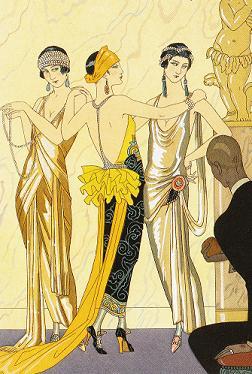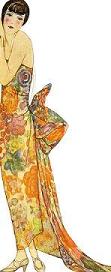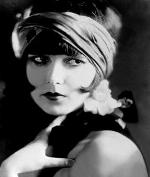Exotic Fashions and Style: Art Deco in the 1920s
One of the most recognizable things about the 1920s is the influence of Art Deco fashion.
The fashion of the Jazz Age goes far beyond the cloche hat and the flapper dress.
A Brief History of Art Deco
The first reference to Art Deco was actually not made until 1969 by a writer named Bevis Hillier. The term was used to refer to an aesthetic and period of art between 1909 and 1939.
This period was certainly not limited to fashion. It included architecture, painting, textiles and fashion. Its influence trickled down through photography and film as well.

The movement spun off from the avant-garde movements of the Cubist and Fauve painters in the early years of the 20th century.
Art deco fashion was deeply influenced by the Ballet Russes (The Russian Ballets) directed by Russian choreographer Segei Pavlovich Diaghilev (Serge to his friends).
Serge's desire to introduce a more "exotic" feel to what he saw as bland Russian ballet spured him to commission work from these avant-garde movement of 1909.
This set the stage for the Art Deco movement that would follow. The Ballet Russes were distinguished by the deep colors and costumes which accentuated a woman's natural figure.
Under the keen eye and skilled hands of Paul Poiret, Art Deco fashion bloomed. Poiret's eye transformed the fashions of the late 19th century and made it new with the influence of western fashion and combined it with the "exotic" influence of ancient Egypt and regional folk styles.
Art Deo was a combination of many different aesthetics and was spurred forward by the blossoming of art, ballet, theatre and films.
The "Simple" Look
 Dress Designed By Paul Poiret
Dress Designed By Paul PoiretUnlike the flowing big breasts, small waists and large butts of the Victorian Era, modern 1920s fashion was marked by the newfound simplicity and a richness in color and fabric that defines the period.
Art Deco fashion relied heavily on beautifully textured richly dyed fabrics that lent depth to the simple angular lines of the dresses. These dresses relied more upon simple shapes combined with the bold colors and textures textiles to the depth, beauty and overall effect of the fashion.
Androgyny - The Gender Crisis of the 1920s
Many fashion critics describe 1920s fashion as having a gender crisis because of the cleaner lines and the de-emphasis on a woman's breasts and butt.
Women went to work during World War One, they had become more active in "mainstream" society and sports. No longer could they wear the heavy petticoats and corsets as they had before.
In 1916 Paul Poiret designed what was called "the Picture Dress" featuring a high waist and resembling the older bodice type dresses of the Victorian Era.
But unlike those dresses the Picture dress allowed a woman more comfort while wearing it. It was designed to be worn at wedding and other formal occasions.
The Height of the 1920s
While the 1920s is known for its short hemmed dresses, really dresses lengths never rose to the knee until 1923.
The famous designs of Coco Chanel and other were influenced by the modern sportswear of the time. Because these dresses were easy to copy and knock off, the better designers complicated their designs by adding structural elements like flared sleeves and extra fabric to make the designs their own.
The Nightlife Culture
In America with Prohibition in full swing in the mid-1920s there was a definite emphasis on living a lavish lifestyle and going to speakeasies and nightclubs around the country.
The evening dresses reflected ladies' desire to dance without being limited by her clothes. Her dress was typically held up by narrow straps on the shoulder and had slits down the thigh to allow her complete freedom while doing "The Charleston".
To stay warm women would wrap themselves in shawls inspired by Japanese fabrics and motifs.
Art Deco fashion was always classy and integrated fine materials and craftsmanship into their design.
Visit Marta's site to learn more about Art Deco Style.
